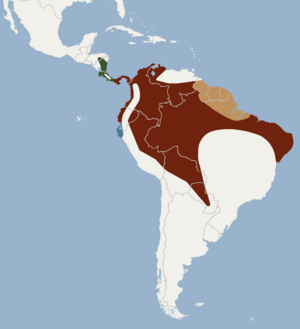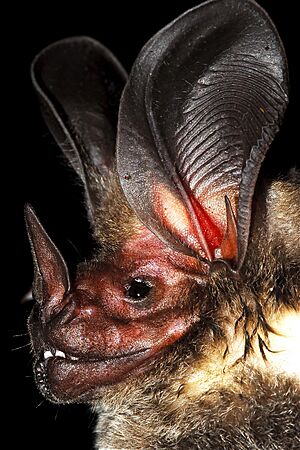White-throated round-eared bat facts for kids
Quick facts for kids White-throated round-eared bat |
|
|---|---|
 |
|
| Conservation status | |
| Scientific classification | |
| Genus: |
Lophostoma
|
| Species: |
silvicola
|
 |
|
| Distribution of the white-throated round-eared bat Red = L.s.silvicolum |
|
The white-throated round-eared bat (Lophostoma silvicola) is a fascinating bat species. You can find it in many countries, from Honduras in Central America all the way to Bolivia, Paraguay, and Brazil in South America. This bat has a very unique home: it lives inside the nests of termites! Specifically, it likes the nests of a termite called Nasutitermes corniger. These bats mostly eat insects, which they find on the surface of leaves. They also enjoy eating fruit and pollen. Because there are so many of these bats across a huge area, the International Union for Conservation of Nature says they are a "least concern" species. This means they are not currently in danger of disappearing.
Contents
Meet the White-Throated Bat: What's in a Name?
This bat was first described in 1836 by a French scientist named Alcide d'Orbigny. When scientists describe a species, they give it a special two-part name, like Lophostoma silvicola. This helps everyone know exactly which animal they are talking about.
Scientists also divide species into smaller groups called subspecies. Think of them like different versions of the same animal, often living in different places. There are four known subspecies of the white-throated round-eared bat:
- L. s. silvicola: Found in southern Panama, Colombia, Venezuela, parts of Brazil, Ecuador, Peru, Bolivia, and Paraguay.
- L. s. centralis: Lives in southern Honduras, Nicaragua, Costa Rica, and northern Panama.
- L. s. laephotis: Found in Guyana, Suriname, French Guiana, and northeastern Brazil.
- L. s. occidentalis: Lives in northeastern Peru and southeastern Ecuador.
What Does the White-Throated Bat Look Like?
The white-throated round-eared bat is a medium-sized bat. Its forearm, which is like its arm bone, is about 50 mm (2 in) long or more. It has soft, long fur on its body, but the fur on its face is very short.
Its back fur is grey or brownish-grey, and it looks a bit frosty because many hairs have white tips. The fur on its belly is a lighter greyish-brown. A cool feature is its throat, which is completely white! Its snout is bare, meaning it has no fur. It also has a special leaf-shaped structure on its nose called a nose-leaf. This nose-leaf is pointed and attached to its upper lip.
On its chin, it has a groove in the middle surrounded by tiny bumps. Its ears are big and round, which helps it hear very well. Its tail is about halfway as long as the membrane between its legs, which is called the patagium. Some bats in Ecuador even have bright white patches behind their ears!
Where Do White-Throated Bats Live?
The white-throated round-eared bat lives in Central America and the northern part of South America. You can find them mostly to the east of the Andes mountains. They are not found in most of the Amazon rainforest.
These bats live in many different kinds of forests. They can also be found in clearings within forests and even over farmland. They usually avoid areas near creeks or streams.
Life of the White-Throated Bat: Diet and Home
The white-throated round-eared bat mainly eats insects. It's quite clever at hunting! It flies around and picks insects right off the top surface of leaves. Besides insects, it also eats fruits to get more nutrients.
One of the most amazing things about this bat is where it chooses to live. It makes its home inside the active nests of termites! The male bats actually dig out cavities at the bottom of these termite mounds.
Why would a bat want to live in a termite nest? There are several good reasons:
- Less Competition: Other bat species usually don't want to live in termite nests, so these bats have less competition for good roosting spots.
- Fewer Parasites: Termite nests might have fewer parasites that bother bats.
- Safer from Predators: Living inside a tough termite mound offers good protection from animals that might want to eat them.
- Comfortable Temperature: Termite nests keep a steady temperature inside, which is perfect for the bats.
On Barro Colorado Island in Panama, these bats only use the nests of the Nasutitermes corniger termite. Scientists have found up to nineteen bats living together in just one of these termite roosts! It's very rare for bats to actively build their own homes like this.



